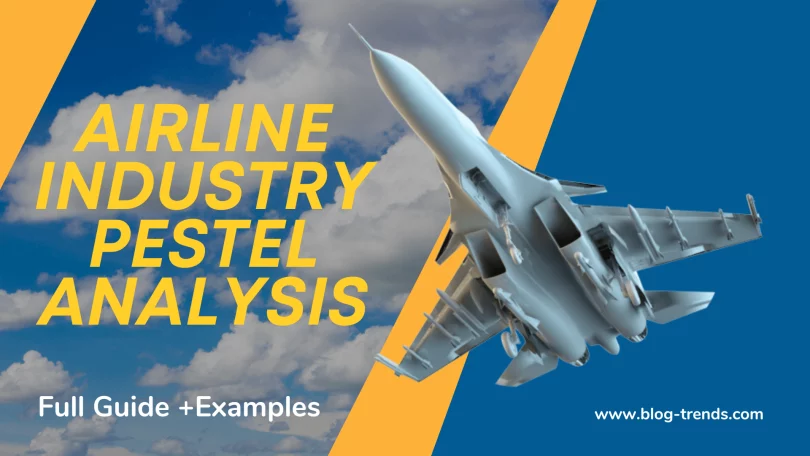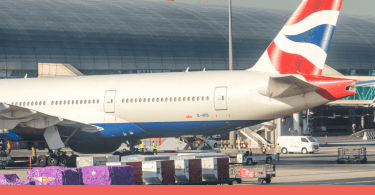Airline industry overview
The airline industry, a global force of connectivity, is undergoing a profound transformation. To investigate the main factors that impact positively or negatively the growth and the sustainability of this sector, we present our complete “PESTEL analysis of the airline industry”.
Within this article, we discuss the global impact of the macro factors on the airline sector. Prepare to embark on a journey where data-driven insights guide the way as we reveal the strategies that drive change and success in the aviation world.
Political environment
The international political environment can impact the airline industry’s growth in both positive and negative ways. Some of the key factors to consider include:
Positive impacts:
Increased international trade and investment:
Governments that support open trade and investment policies can help to boost demand for air travel. For example, the Regional Comprehensive Economic Partnership (RCEP), which is the world’s largest free trade agreement, is expected to increase trade in the Asia-Pacific region by 2.9% annually.
This could lead to significant growth in air travel between countries in the region.
Improved relations between countries:
When countries have good relations, they are more likely to sign open skies agreements, which allow airlines to operate more freely between their territories. This can lead to increased competition and lower fares, which can stimulate demand for air travel.
For example, the recent improvement in relations between the United States and Cuba has led to an increase in air travel between the two countries.
Government support for the airline industry:
Governments can support the airline industry through a variety of measures, such as tax breaks, infrastructure investment, and financial assistance.
This can help to reduce costs and make airlines more competitive. For example, the US government provided billions of dollars in financial assistance to the airline industry during the COVID-19 pandemic.
Negative impacts:
Political instability and conflict:
Political instability and conflict can deter people from traveling and can lead to disruptions to air travel. For example, the ongoing conflict in Ukraine has led to a significant decline in air travel to the country.
Government regulations:
Governments can impose a variety of regulations on the airline industry, such as safety regulations, environmental regulations, and foreign ownership restrictions. These regulations can increase costs and make it more difficult for airlines to operate.
For instance, the European Union has strict environmental regulations for airlines, which can increase the cost of operating flights to and from Europe.
Geopolitical tensions:
Geopolitical tensions between countries can lead to travel restrictions and increased security costs for airlines. For example, the US government imposed travel restrictions on citizens from several Muslim-majority countries in 2017. This led to a decline in air travel between the United States and these countries.
Overall, the airline industry is facing a number of challenges, but it also has the potential for significant growth in the coming years. The impact of the international political environment on the industry will depend on a variety of factors. Still, governments will play a key role in shaping the industry’s future.
Economic environment
The international economic conditions are expected to have a substantial effect on the growth of the airline industry in the coming years. Here are some of the key factors to consider:
Unemployment:
High unemployment rates can lead to a decrease in demand for air travel, as people have less disposable income to spend on vacations and business trips.
Inflation:
High inflation can also reduce demand for air travel as people’s purchasing power deteriorates. Additionally, inflation can increase the costs of operating an airline, such as fuel and labor costs.
Exchange rates:
Favorable exchange rates can make air travel more affordable for people in some countries, while unfavorable exchange rates can make it more expensive.
Recession:
The COVID-19 pandemic has had a devastating impact on the airline industry. Global passenger traffic fell by 60% in 2020, and many airlines were forced to ground their fleets or operate at a fraction of their capacity.
The pandemic has had a number of negative impacts on the airline industry, including:
Reduced demand for air travel: Due to travel restrictions and public health concerns, people have been traveling less frequently since the start of the pandemic.
Increased costs: Airlines have had to implement a number of new measures to protect passengers and staff from COVID-19, such as enhanced cleaning and ventilation procedures, social distancing measures, and mask requirements. These measures have increased the cost of operating an airline.
Supply chain disruptions: The pandemic has also disrupted the supply chain for the airline industry, making it difficult to obtain essential parts and supplies.
As a result of these factors, many airlines have suffered significant financial losses during the pandemic. Some airlines have been forced to declare bankruptcy, while others have been forced to make deep cuts to their workforce.
The airline industry is slowly recovering from the pandemic, but it is still facing a number of challenges. Passenger traffic is still below pre-pandemic levels, and airlines are still struggling to control costs. Additionally, the war in Ukraine has led to higher fuel prices, which is another challenge for the airline industry.
It is important to note that the airline industry is also cyclical, meaning that it is subject to periods of growth and contraction. The international economic environment can play a role in determining the timing and severity of these cycles.
Socal environment
In the years ahead, the global social and cultural environment is poised to exert a substantial influence on the growth of the airline industry.
Here are several key factors to take into account:
Changing customer habits:
Customers are increasingly demanding more personalized and convenient travel experiences. This is leading to a shift away from traditional travel packages and towards more customized travel arrangements.
Digital natives:
Digital natives are people who have grown up with the internet and digital technology. They are more likely to use online platforms to book and manage their travel. Additionally, digital natives are more likely to be interested in new travel experiences and destinations.
Globalization:
Globalization is leading to increased cultural exchange and travel between different countries. This is creating new opportunities for airlines to expand their networks and reach new customers.
Lifestyles:
People are increasingly living more active and cosmopolitan lifestyles. This is leading to increased demand for travel for both leisure and business.
The airline industry is constantly evolving to meet the changing needs of its customers. By understanding the key social and cultural trends that are shaping the world, airlines can position themselves for success in the coming years.
Technological environment
Technology is constantly evolving, and the airline industry is no exception. A several technological factors will have a considerable influence on the airline industry in the coming years, including:
Artificial intelligence (AI):
AI is already being used by airlines in a number of ways, such as to improve customer service, optimize flight schedules, and reduce costs.
In the future, AI is expected to play an even greater role in the airline industry, such as in the development of autonomous aircraft and predictive maintenance systems.
Big data:
Airlines are collecting vast amounts of data about their customers, aircraft, and operations. This data can be used by airlines to improve their efficiency and effectiveness in a number of ways, such as by optimizing flight schedules, reducing fuel consumption, and providing more personalized customer experiences.
Internet of Things (IoT):
The IoT is a network of physical devices that are connected to the internet and can collect and exchange data. This technology is already being used by airlines to track luggage, monitor aircraft performance, and improve airport operations.
In the future, the IoT will play an even greater role in the airline industry, such as in the development of predictive maintenance systems and smart airports.
Blockchain:
Blockchain is a distributed ledger technology that can be used to securely and transparently record transactions. This technology has the potential to revolutionize a number of industries, including the airline industry.
For example, blockchain could be used to create a more efficient and secure system for booking and managing flights.
Autonomous aircraft:
Autonomous aircraft are aircraft that can fly without human intervention. This technology is still in its early stages of development, but it has the potential to revolutionize the airline industry.
Autonomous aircraft could be used to reduce the cost of air travel, improve safety, and expand access to air travel to new destinations.
In addition to these specific technologies, the overall trend toward digitalization is expected to have a significant impact on the airline industry in the coming years.
Airlines are increasingly using digital technologies to improve their efficiency and effectiveness, as well as to provide new and innovative services to their customers.
Ecological environment
Ecological factors are having a growing impact on the airline industry, both today and in the coming years. Some of the key ecological factors that are affecting the airline industry include:
Climate change:
Climate change is having a number of impacts on the airline industry, including more extreme weather events, such as hurricanes and typhoons, which can disrupt flights and damage infrastructure.
Climate change is also leading to rising sea levels, which could threaten airports and other coastal infrastructure.
Air pollution:
Air pollution from aircraft emissions is a growing concern. Aircraft emissions contribute to greenhouse gas emissions, which are driving climate change.
Aircraft emissions also contribute to air pollution in local communities, which can have negative health impacts on citizens.
Noise pollution:
Aircraft noise pollution is another concern. Aircraft noise can be disruptive to people who live near airports and flight paths. Aircraft noise can also have negative impacts on wildlife.
In addition to these specific ecological factors, the overall trend towards environmental awareness is expected to have a significant impact on the airline industry in the coming years.
Customers are increasingly demanding more sustainable travel options, and airlines are under pressure to reduce their environmental impact.
The airline industry is taking measures to address ecological challenges. For example, airlines are developing new fuel-efficient aircraft and investing in sustainable aviation fuels. Additionally, airlines are working to reduce their waste and improve their energy efficiency.
The airline industry will need to continue to innovate and adapt to meet the growing ecological challenges that it faces. By reducing its environmental impact, the airline industry can protect the planet and ensure its long-term sustainability.
Legal environment
Legal aspects can play a significant role in shaping the trajectory of the airline industry’s growth. Here are some of the key legal factors that might influence the industry in the upcoming years:
Aviation safety regulations:
Aviation safety is a top priority for governments around the world. Airlines are subject to a variety of safety regulations, and these regulations are constantly being updated to reflect new technologies and best practices. Airlines that fail to comply with safety regulations can face fines, penalties, and even grounding orders.
Environmental regulations:
Airlines are also subject to a variety of environmental regulations, such as limits on aircraft emissions and noise pollution. These regulations are designed to protect the environment and reduce the negative impacts of air travel. Airlines that fail to comply with environmental regulations can face fines and other penalties.
Competition regulations:
Airlines operate in a highly competitive environment. Governments typically have competition regulations in place to prevent anti-competitive behavior, such as price fixing and collusion. Airlines that violate competition regulations can face fines and other penalties.
Consumer protection regulations:
Airlines are also subject to consumer protection regulations, which are designed to protect the rights of passengers. These regulations cover a variety of issues, such as ticket refunds, cancellations, and baggage handling. Airlines that violate consumer protection regulations can face fines and other penalties.
The airline industry is working to address the legal challenges that it faces. For example, airlines are investing in new safety technologies and procedures. Additionally, airlines are working to reduce their environmental impact and to comply with new environmental regulations.
Airline Industry Pestel Analysis Summary
To summarize the results of the airline industry Pestel analysis, we present the main opportunities and threats related to the macro environment of this business.
The table below summarizes the key opportunities and threats associated with each component of the airline industry PESTEL analysis, as discussed in the article.
| Components | Opportunities | Threats |
|---|---|---|
| Political Environment | -Increased international trade and investment;
-Improved relations between countries; -Government support for the airline industry. | -Political instability and conflict between countries, like the impacts of the war in Ukraine;
-Government regulations; -Geopolitical tensions |
| Economic Environment | -Strong economic growth;
-Low unemployment rates; -Favorable exchange rates. | -Negative economic impacts of the COVID-19 pandemic. |
| Social Environment | – Changing customer habits;
– Digital natives and online bookings; – Globalization and diverse customer base; – Active and cosmopolitan lifestyles. | – Failure to adapt to changing customer preferences. |
| Technological Environment | – Utilizing AI for improved services and cost reduction;
– Big data for efficiency and personalization; – IoT for tracking and operational improvements; – Blockchain for secure bookings; – Potential for autonomous aircraft | – Rapid technological changes and integration challenges. |
| Ecological Environment | – Development of sustainable practices;
– Innovation in fuel efficiency and sustainability; – Reduced waste and energy efficiency improvements; Increasing demand for sustainable travel. | – Climate change impacts and disruptions;
– Air pollution and emissions regulations; – Noise pollution and community concerns |
| Legal Environment | -Open skies agreements;
-Complying with aviation safety and environmental regulations; -Adhering to competition and consumer protection laws. | -Strict safety and environmental regulations;
-Foreign ownership restrictions; -Consumer protection regulations and penalties. |
Conclusion
In conclusion, this PESTEL analysis of the airline industry has allowed us to deeply examine the macro factors of this industry on a global scale.
As a result, we can identify the main opportunities and threats that airline companies should consider when planning strategically for the coming years.
While the Pestel framework is a relevant and effective strategic analysis framework, it must be complemented by other analyses if you want to well understand your business’s environment.
These include Michael Porter’s Five Forces model, which allows you to analyze your industry’s competitive intensity and degree of attractiveness, and the VRIO model, which examines your company’s resources and specific skills.
Hopefully, this example of the airline industry Pestel analysis has helped you better understand the use and implementation of the Pestel framework in your company, don’t forget to share this article with your friends and family!
PESTEL analysis examples 2024
To better understand the PESTEL analysis, we invite you to read our recent free examples of the Pestel framework.
PESTEL analysis of DHL
Click here to read our example of DHL’s PESTEL analysis.
PESTEL analysis of FedEx
Click here to read our example of FedEx’s PESTEL analysis.
PESTEL analysis of Chipotle
Click here to read our example of Chipotle’s PESTEL analysis.
PESTEL analysis of Brazil
Click here to read our example of Pestel’s analysis of Brazil.
PESTEL analysis of Spotify
Click here to read our example of Spotify Pestel analysis.
Chick-fil-A PESTEL Analysis
Click here to read our example of Chick-fil-A Pestel analysis.
Costco PESTEL Analysis
Click here to read our example of Costco Pestel analysis.
Microsoft PESTEL Analysis
Click here to read our example of Microsoft Pestel analysis.
Disney PESTEL Analysis
Click here to read our example of Disney Pestel analysis.
Walmart Pestel Analysis
Click here to read our example of Walmart Pestel analysis.
Amazon Pestel Analysis
Click here to read our example of Amazon Pestel analysis.
McDonald’s Pestel Analysis
Click here to read our example of the Netflix Pestel analysis.
Netflix Pestel Analysis
Click here to read our example of the Netflix Pestel analysis.
Apple Pestel Analysis
Click here to read our example of the Apple Pestel analysis.
Twitter Pestel Analysis
Click here to read our example of the Twitter Pestel analysis.
Facebook Pestel Analysis
Click here to read our example of the Facebook Pestel analysis.
Pestel analysis of the Social Media industry
Click here to read our example of the Pestel analysis of the Social Media industry.
IKEA Pestel Analysis
Click here to read our example of the IKEA Pestel analysis.
TESLA Pestel Analysis
Click here to read our example of the TESLA Pestel analysis.












Leave a Comment